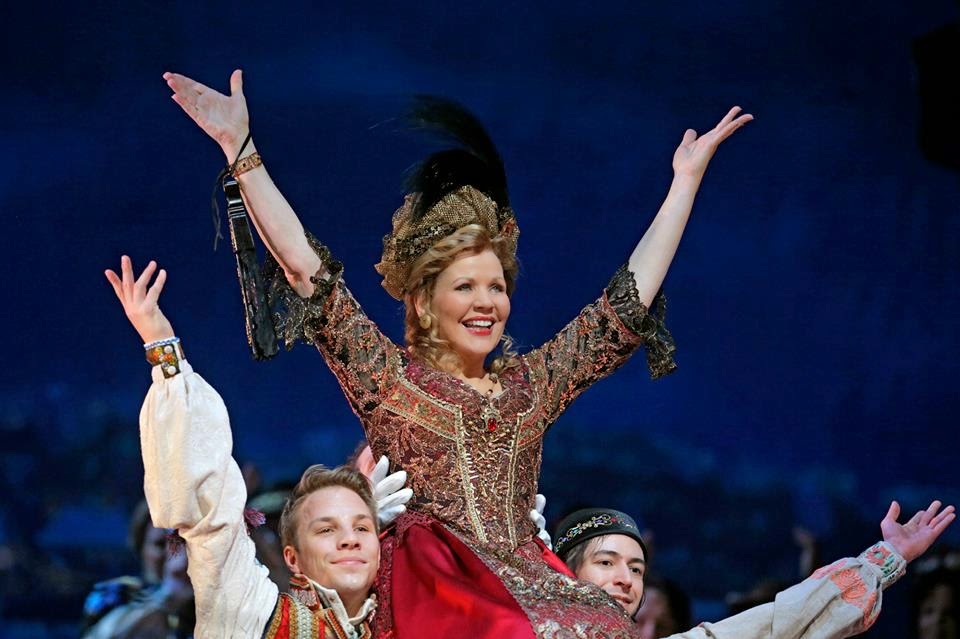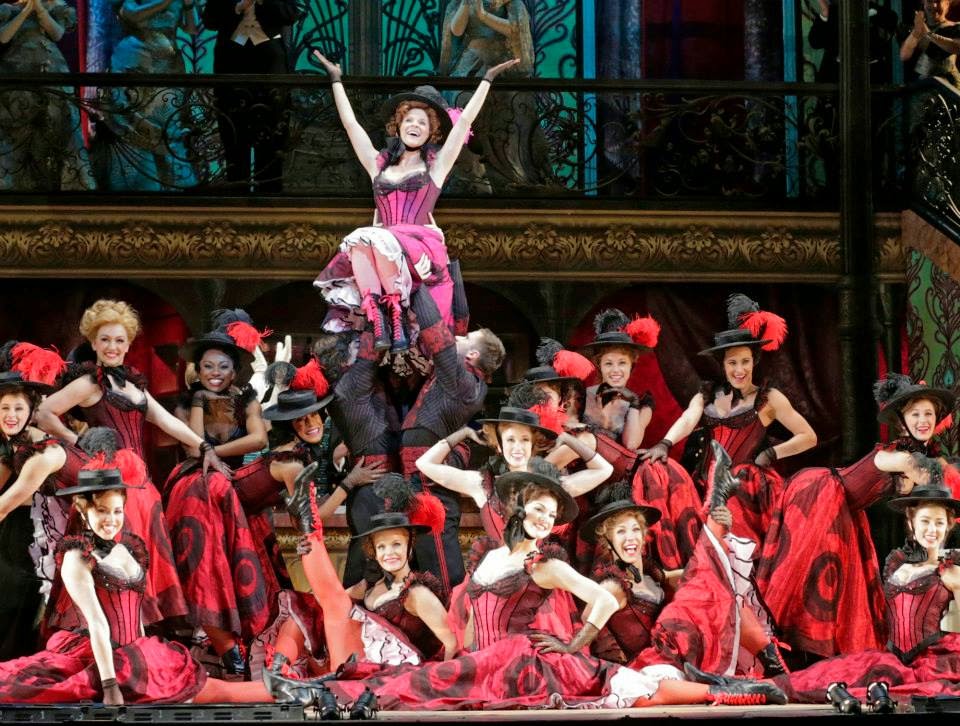Elizabeth – The Met’s new production of Merry Widow has been described as a transitional vehicle for Renee Fleming’s move out of opera and into Broadway. With Broadway producer/choreographers and actors all around her on her home court, it would seem Fleming would shine. And while Fleming clearly is the star, it was a shame her voice wasn’t up for the show the other night, as the house was packed for her (and ticket prices increased from usual rates). The operetta overall was fun and light, the definition of an operetta, but I found it a bit too light in some aspects. The set was incredibly shallow, using up what looked like barely a third or half of the stage a typical Met production uses. I was expecting the stage to open up later on in some sort of big reveal—why else would set designer Julian Crouch use so little of the Met’s big stage—but it never happened.
There were long stretches of talking which I felt left the audience’s energy sagging. Not helping were Jeremy Sams’ rhyming couplets. I found them irritating and unnatural from the start. This is the same mastermind who created the wonderfully fun pastiche opera, Enchanted Island—and directed the über talky Fledermaus last year. If only we could have more of the enchanting Sams creations. Sir Thomas Allen as Baron Zeta did very well with the English operetta, his diction was amazingly clear—undoubtedly assisted by the reported amplification (of speaking parts only, of course) by the Met’s speaker system.
Susan Stroman’s choreography was fun and showcased the singers’ acting and dancing abilities. The Broadway elements she brought to the Met seemed fitting for the Merry Widow, especially given all the dance sequences this operetta has. I was surprised to see the grisettes dancing andsinging. When first pointed out to me I thought certainly the choristers onstage must have been singing, but it actually was the dancers. Kelli O’Hara as Valencienne did a superb job—her voice was great, especially considering she’s technically a Broadway performer, and I enjoyed her comedic acting. I do wonder what the infiltration of Broadway directors and performers means for the Met. Is it possible the Met cannot sustain itself solely through quality opera? Does it need the flashy Rigoletto sets of Michael Mayer and the draw of Broadway names like Julie Taymor to increase attendance? And if it does, what does that mean for the future of opera? Perhaps Fleming’s crossover move is the future of the opera—a fusion or a blurring of the lines between Broadway and opera. And I can’t help but think that’s a good thing. One of the other unfortunate elements to the Merry Widow was the tightly controlled and rigid conducting of Sir Andrew Davis. The singers and dancers seemed to want to loosen up, but the rigidity of Davis didn’t allow the opera to bloom into the frolic it could have been.
With talk of Fleming moving away from opera into Broadway, and Broadway coming to the Met I realized what a strange relationship I have to Fleming compared with most operagoers. My first experiences with her are not as an artist, but rather as a celebrity. The first time I saw her was on David Letterman singing the Top Ten list. The next time was performing the national anthem at the Superbowl. Six days after the Super Bowl I saw Rusalka, the only opera in which I have seen her. After that it was her jazzy appearance in this year’s Macy’s Thanksgiving Day parade alongside KISS. And now Merry Widow and back to Fleming’s opera origins.
I’ve heard Carlisle Floyd speak often about how much he likes Fleming’s performances of his Susannah, so I finally listened to some on Youtube to get more of a sense of Fleming. I can’t imagine the person I heard the other night singing Susannah. She was a completely different person in those recordings; or more accurately, a completely different character. It is a testament to Fleming’s range as a singer and actor and it gave me more respect for the person singing the Top Ten list of operatic lyrics on Letterman. Yet to me, my initial imprint of her cannot be undone. When I think of Renee Fleming, KISS comes to mind before Hanna Glawari. And I can’t help but think that Fleming may even approve.
 Shawn – The new production of The Merry Widow at the Met was absolutely packed on Saturday. The weather was miserable so we used the underground entrance but I would imagine the ticket scalpers were having a field day upstairs.
Shawn – The new production of The Merry Widow at the Met was absolutely packed on Saturday. The weather was miserable so we used the underground entrance but I would imagine the ticket scalpers were having a field day upstairs. I had forgotten how strangely beautiful the Met can look when sold out. All those neatly aligned symmetrical rows of heads, without any of the huge gaps and empty spaces that have been almost the norm of late. Quite lovely. And the capacity crowd was positively pumped. Renee Fleming is a greatly beloved figure. Fleming’s first entrance was met with such an extended round of applause from the audience that conductor Sir Andrew Davis finally had to jumpstart the orchestra to silence the ovation and get the action going again. Entrance applause is not something I’m a huge fan of in general but the length and intensity of Fleming’s entrance ovation was pretty striking. The audience was ready to have a good time. And they did. They cheered and laughed and even clapped in time with orchestra on several occasions.
I had less of a good time sadly. I found much of The Merry Widow dull and slow. This could be a failing of the show, it was my first time seeing it. But my mind wandered greatly. I watched long stretches through my opera glasses. Something I often do when I am bored. I’ll pick a supporting cast member or chorister and watch them for an extended period to see if I can discern their acting choices. Kind of creepy of me I agree, but it’s a survival mechanism.
Renee Fleming’s acting was fine, if a bit general. There were moments when I was not sure what she was playing other than general, distant aloofness. But again the audience seemed to adore her every action.
The rest of the cast was game. This kind of thing is Nathan Gunn’s bread and butter it seems so he was solid, and Sir Thomas Allen showed surprisingly excellent comic timing. Kelli O’Hara was excellent and her acting proved specific comic acting choices CAN be read clearly in the cavernous house of the Met, even in the back of Dress Circle where we were sitting. The excellent Carson Elrod as Njegus demonstrated the same thing.
However, what I was really thinking about for the last hour the performance was if this production was paving the way for the Met doing actual musicals. Saturday’s audience felt stacked with more musical/broadway fans than usual. I saw far more audience iPhone photos being taken during Merry Widow than I have ever seen at any other show at the Met and their general enthusiasm felt more Mama Mia than Traviata.
Last year, Lyric Opera of Chicago’s production of Sound of Music was the top selling production in Lyric’s history selling 71,074 tickets. Of those, 41,233 were purchased by people attending Lyric for the first time. It remains to be seen if any of those first timers return to Lyric to see non-musical fare, but surely some will no? At least twelve I’m sure, but hopefully more. But regardless with numbers like that, and the Met on the verge of pawning their Chagalls for laundry money, it may just be a matter of time before the Met follows suit and does a mainstream musical. We’re taking predictions on what it might be. So guess away. And go long.
Related Links:



Leave a Reply